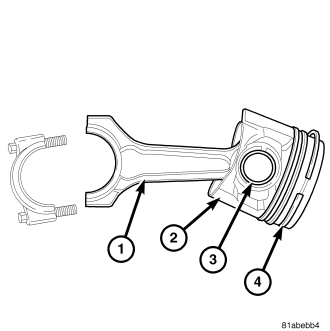INSPECTION
PISTONS

1.
Piston Diameter: Size: 91.912-91.928mm (3.6185-3.6192 in.) Maximum wear limit .05mm (.0019 in.).
2.
Check piston pin bores in piston for roundness. Make 3 checks at 120 degrees intervals. Maximum out of roundness .05mm (.0019in.).
3.
The piston diameter should be measured approximately 15 mm (.590 in.) up from the base.
4.
Skirt wear should not exceed 0.1 mm (.00039 in.).
5.
The clearance between the cylinder liner and piston should not exceed 0.065-0.083 mm (.0025-.0032 in.).
CONNECTING RODS

CAUTION:
Connecting rod bolts must be replaced when disassembled. When assembling the connecting rod (2), be sure that the connecting rod pawl (1) on each of the connecting rod caps
is facing the rear (fly wheel) side of the engine.
NOTE:
Do Not lubricate the new connecting rod bolts. They are already coated with a anti scuff treatment.
1.
Assemble connecting rod bearings (4) and bearing caps to their respective connecting rods (2) ensuring that the serrations on the cap and reference marks are aligned.
2.
Tighten connecting cap bolts to 10 Nm (88 in. lbs.).
3.
Without loosening connecting rod bolts, tighten all bolts to 30Nm (22 ft.lbs.).
4.
Using a torque angle gauge, tighten each bolt an additional 40 degrees .
5.
Recheck all bolt tightening with a torque wrench set to 88Nm (65 ft.lbs.).
6.
Check and record internal diameter of crank end of connecting rod (2).
CAUTION:
When changing connecting rods (2), DO NOT use a stamp to mark the cylinder location. Identify the connecting rods (2) and caps location using a paint marker.
All four must have the same weight and the same number. Replacement connecting rods (2) will only be supplied in sets of four.
Connecting rods (2) are supplied in sets of four since they all must be of the same weight category. Max allowable weight difference is 5 gr.
PISTON PINS

1.
Measure the diameter of piston pin in the center and both ends.For specification,
(Refer to 9 - ENGINE - SPECIFICATIONS),
(Refer to 9 - ENGINE - SPECIFICATIONS).



